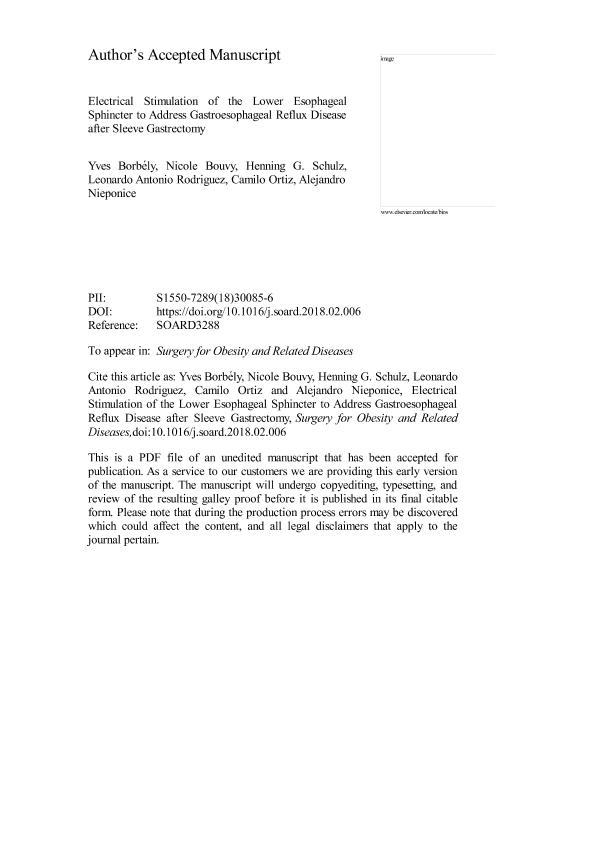Artículo
Electrical stimulation of the lower esophageal sphincter to address gastroesophageal reflux disease after sleeve gastrectomy
Borbely, Yves; Bouvy, Nicole; Schulz, Henning; Rodriguez, Leonardo Antonio; Ortiz, Camilo; Nieponice, Alejandro

Fecha de publicación:
05/2019
Editorial:
Elsevier Science Inc
Revista:
Surgery for Obesity and Related Diseases
ISSN:
1550-7289
Idioma:
Inglés
Tipo de recurso:
Artículo publicado
Clasificación temática:
Resumen
Background: Laparoscopic sleeve gastrectomy (LSG) can result in de novo and worsen preexisting gastroesophageal reflux disease (GERD). Post-LSG patients with GERD refractory to proton pump inhibitors (PPI) usually undergo more invasive, anatomy-altering Roux-en-Y gastric bypass surgery. Lower esophageal sphincter (LES) electrical stimulation (ES) preserves the anatomy and has been shown to improve outcomes in GERD patients. Objective: To evaluate the safety and efficacy of LES-ES in post-LSG patients with GERD not controlled with maximal PPI therapy. Setting: Prospective, international, multicenter registry. Methods: Patients with LSG-associated GERD partially responsive to PPI underwent LES-ES. GERD outcomes pre- and poststimulation were evaluated based on quality of life, esophageal acid exposure (after 6–12 mo), and PPI use. Results: Seventeen patients (11 female, 65%), treated at 6 centers between May 2014 and October, 2016 with a median follow-up of 12 months (range 6–24), received LES-ES. Median age was 48.6 years (interquartile range, 40.5–56), median body mass index 31.7 kg/m2 (27.9–39.3). All patients were on at least daily PPI preoperatively; at last follow-up, 7 (41%) were completely off PPI, 5 (29%) took PPI on an intermittent basis, and 5 (29%) were on single-dose PPI. Median GERD–health-related quality of life scores improved from 34 (on-PPI, 25–41) at baseline to 9 (6–13) at last follow-up (off-PPI, P<.001). Percentage of time with esophageal pH<4 improved from 13.2% (3.7–30.7) to 5.8% (1.1–54.4), P =.01. Conclusion: LES-ES in post-LSG patients suffering from symptomatic, PPI-refractory GERD resulted in significant improvement of GERD-symptoms, esophageal acid exposure, and need for PPI. Preserving the post-LSG anatomy, it offers a valid option for patients unable or unwilling to undergo Roux-en-Y gastric bypass surgery.
Archivos asociados
Licencia
Identificadores
Colecciones
Articulos (IMETTYB)
Articulos de INSTITUTO DE MEDICINA TRASLACIONAL, TRASPLANTE Y BIOINGENIERIA
Articulos de INSTITUTO DE MEDICINA TRASLACIONAL, TRASPLANTE Y BIOINGENIERIA
Citación
Borbely, Yves; Bouvy, Nicole; Schulz, Henning; Rodriguez, Leonardo Antonio; Ortiz, Camilo; et al.; Electrical stimulation of the lower esophageal sphincter to address gastroesophageal reflux disease after sleeve gastrectomy; Elsevier Science Inc; Surgery for Obesity and Related Diseases; 14; 5; 5-2019; 611-615
Compartir
Altmétricas



